Complete Solutions to Example of chapter REFRACTION AT SPHERICAL SURFACES of Class 12 book with complete answers and questions
| Class 12 | PHYSICS |
| Chapter | REFRACTION AT SPHERICAL SURFACES |
| CP SINGH | Example |
| Number Of Questions | 70 |
| Academic Year | 2023-24 |
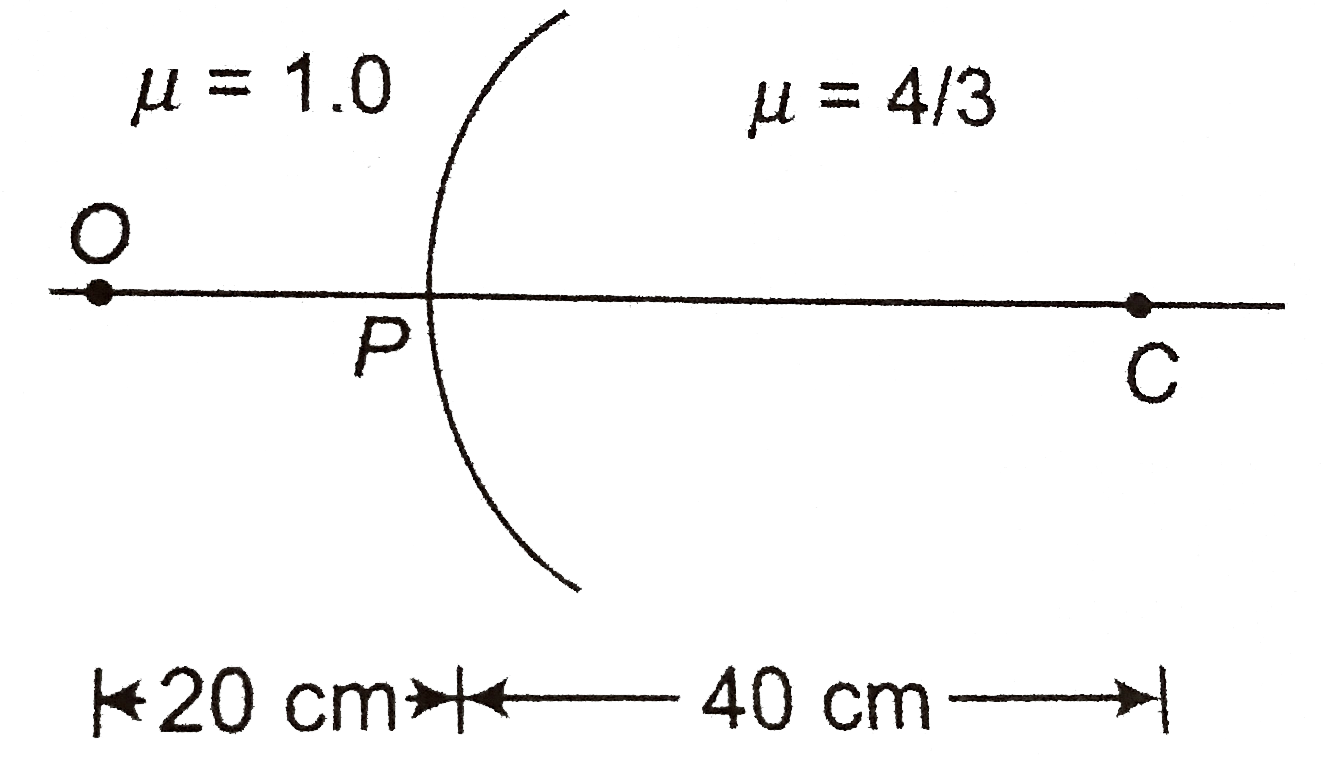
Locate the image of the point object `O`. The point `C` is centre of curvature of the spherical surface.03:45View Solution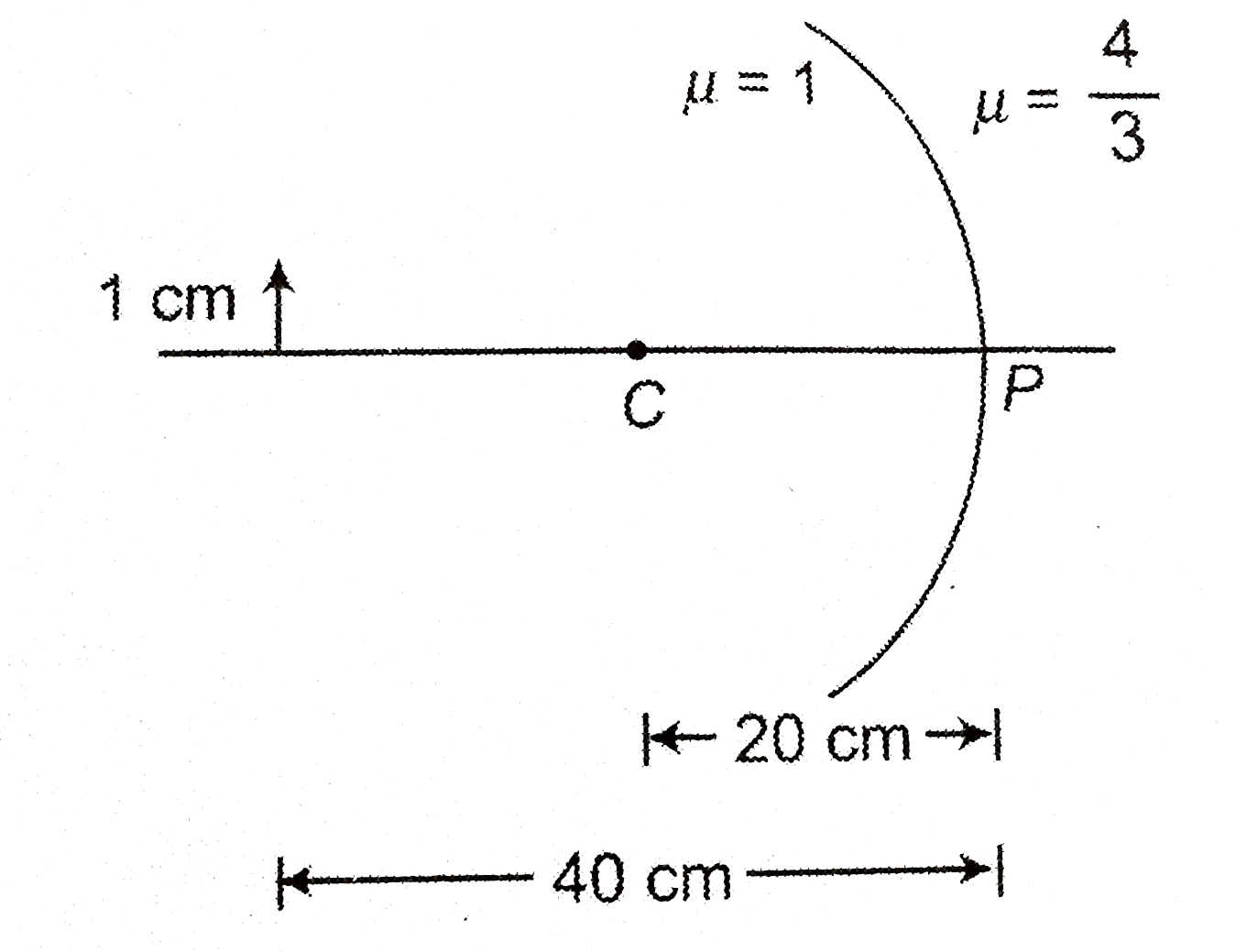
Locate the image and find its height.05:01View SolutionFigure shows an irregular block of material of refractive indec `sqrt(2)`. A ray of light strikes the face AB as shown. After refraction, it is incident on a spherical surface CD of radius of curvature 0.4 m and enters a medium of refractive index 1.514 to meet PQ at E. Find the distance OE up to two places of decimal.
 03:16View Solution
03:16View Solution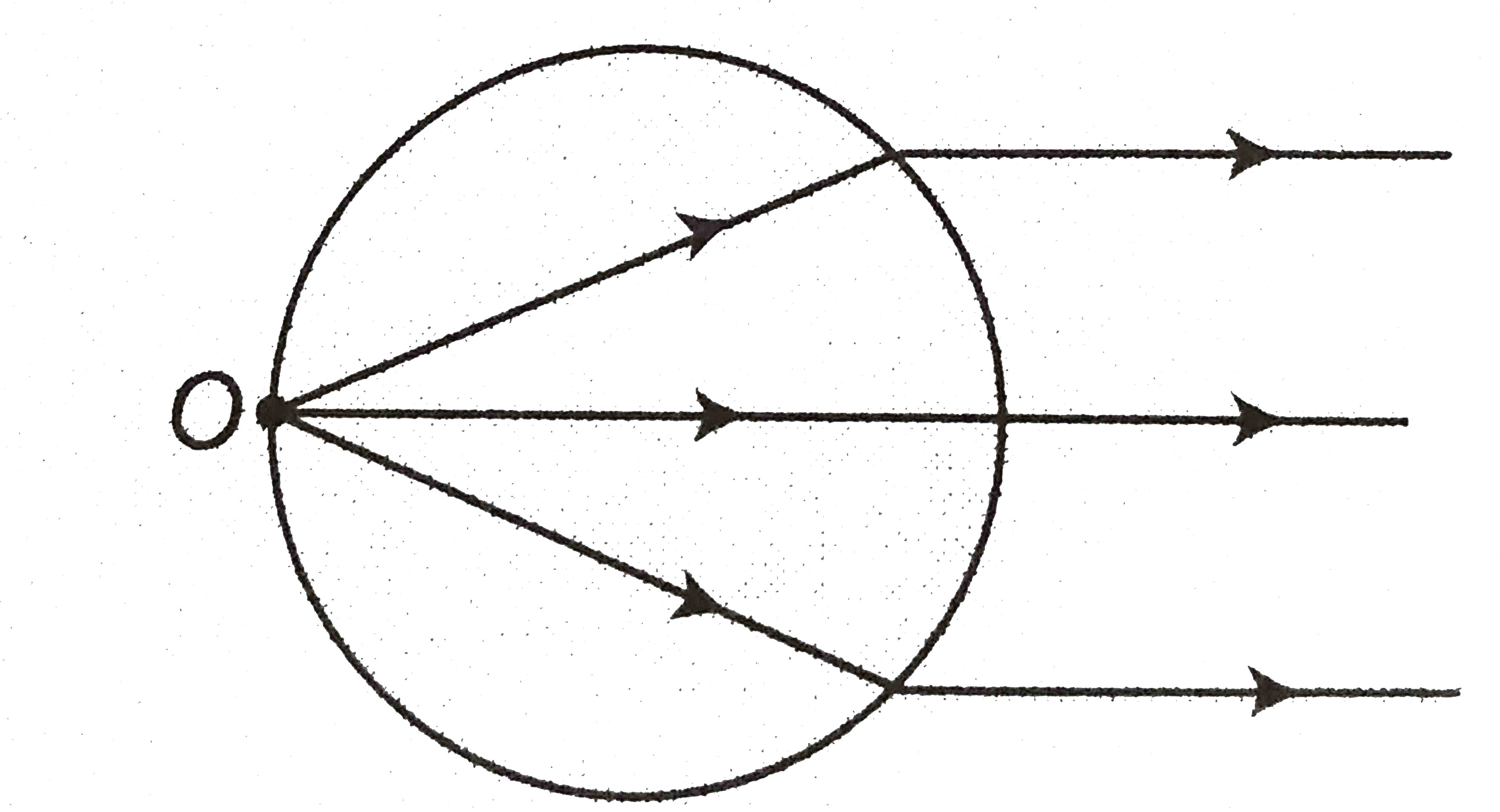
An object `O` is stuck on the surface of a transparent solid spher of radius 20 cm. Find refractive index of the sphere such that rays from the object after refraction from the opposite side emerge as a parallel beam, as shown Also prove that refractive index has the same value in the given situation for any value of radius of sphere.04:26View SolutionA mark of the surface of sphere `(mu=(3)/(2))` is viewed from a diametrically opposite position. It appears to be at a distance 15 cm from its actual position.Find the radius of sphere.
View SolutionA small object stuck on the surface of a glass sphere `(mu=4//3)` is viewed from the diametrically opposite position find transverse magnification.
View SolutionOne end of a horizontal cylindrical glass rod `(mu=1.5)` of radius 5.0 cm is rounded in the shape of a hemisphere. Asnobject 0.5 mm high is placed perpendicular to the axis of the rod at a difference of 20.0 cm from the rounded edge. Locate the image of the object and find its height.
03:40View Solution
Consider the situation shown in figure. The refractive index of medium is `3//2` and its radius of curvature is 330 cm `PO_1=PO_2=10cm` Find distance `O_1` and `O_2` and seen by (a) `O_1` and (b) `O_2`View SolutionAn air bubble in glass `(mu=3//2)` is situated at a distance of 2 cm from centre of sphere of diameter 10 cm. Locate the image of bubble from (a) nearer surface and (b) farther surface.
View SolutionFigure shows a transparent hemisphere of radius 3'0 cm made of a material of refractive index 2.0. (a) A narrow beam of parallel rays is incident on the hemisphere as shown in the figure. Are the rays totally reflected at the plane surface ? (b) Find the image formed by the refraction at the first surface. (c) Find the image formed by the reflection or by the refraction at the plane surface. (d) Trace qualitatively the final rays as they come out of the hemisphere.
 05:36View Solution
05:36View Solution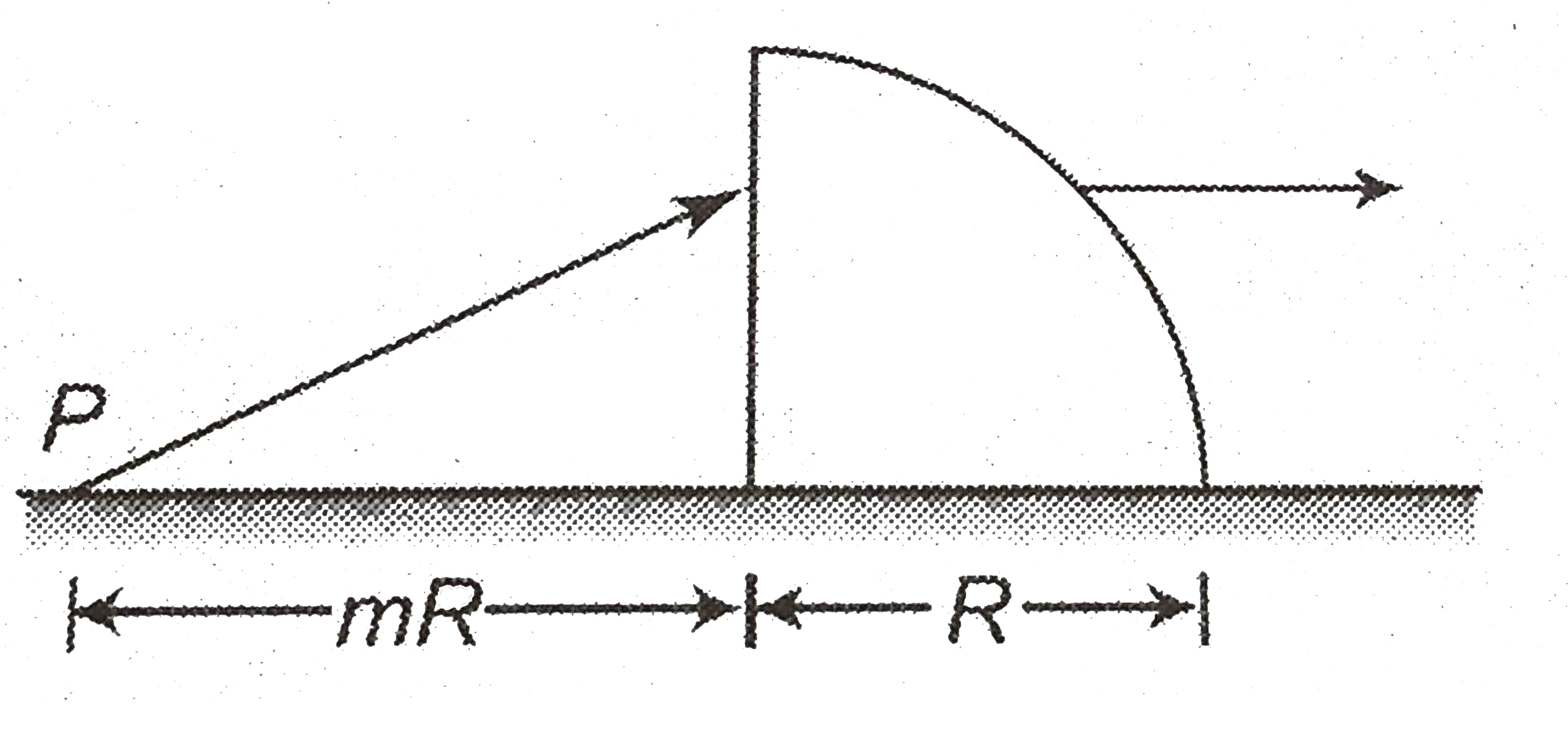
A quarter cylinder of radius R and refractive index 1.5 is placed on a table.A point object P is kept at a distance of mR from it. Find the value of m for whicha ray from P will emerge parallel to the table as shown in the figure.View SolutionA parallel bean of light travelling in water (refractie index `=4/3)` is refracted by a spohereical bubble of radius 2 mm situation in water. Assuming the light rays to be paraxial. i. find the position of the image due to refraction at the first surface and the positoin of the final image, and ii draw a ray diagram showing the positions of oth the images.
07:33View SolutionA hollow sphere of glass of inner and outer radii R and 2R respectively has a small mark on its inner surface. This mark is observed from a point outside the sphere such that the centre of the sphere lies in between. Prove that the mark will appear nearer than it really it, by a distance `(mu-1)(R)//(3mu-1)`
View SolutionA hemispherical portion of the surface of a solid glass sphere (mu = 1.5) of radius r is silvered to make the inner side reflecting. An object is placed on the axis of the hemisphere at a distance 3r from the centre of the sphere. The light from the object is refracted at the unsilvered part, then reflected from the silvered part and again refracted at the unsilvered part. Locate the final image formed.
07:19View Solution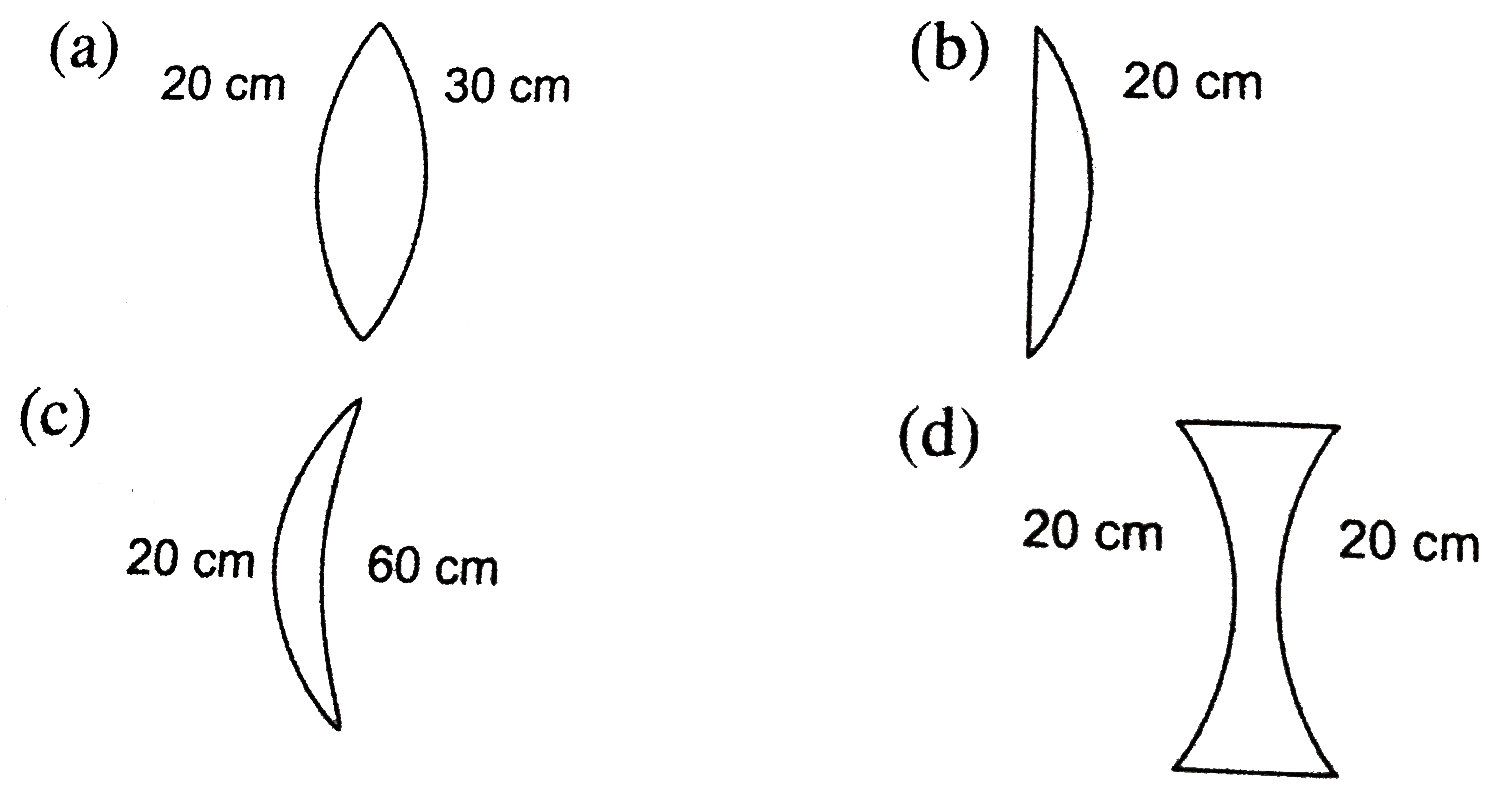
Find focal lengths of lenses made of glass `(mu=3//2)` and placed in air.View SolutionLenses are constructed by a material of refractive indices 1'50. The magnitude of the radii of curvature are 20 cm and 30 cm. Find the focal lengths of the possible lenses with the above specifications.
07:30View SolutionThe radii of curvature fo a lens are `+20cm` and `+30cm` . The material of lens has refractive index `mu=(3)//(2)`. Find fcal length of lens in air.
View SolutionIf in a planoconvex lens, the radius of curvature of the convex surface is `10cm` and the focal length is `30 cm`, the refractive index of the material of the lens will be
02:22View SolutionA thin lens of focal length + 12 cm is immersed in water `(mu = 1.33).` What is its new focal length ?
02:46View SolutionDiameter of a plano-convex lens is 6cm and thickness at the centre is 3mm. If speed of light in material of lens is `2xx10^(8)(m)/(s)`, The focal length of the lens is
03:48View SolutionA spherical air lens of radii `R_1=R_2=10cm`
Is cut in a glass `(mu=1.5)` cylinder. Determine the focal length and nature of air lens. If a liquid of refractive index 2 is filled in the lens, what will happen to its focal length and nature?View SolutionFind the focal length of the lens shown in Fig . The radii of curvature of both the surfaces are equal to R.
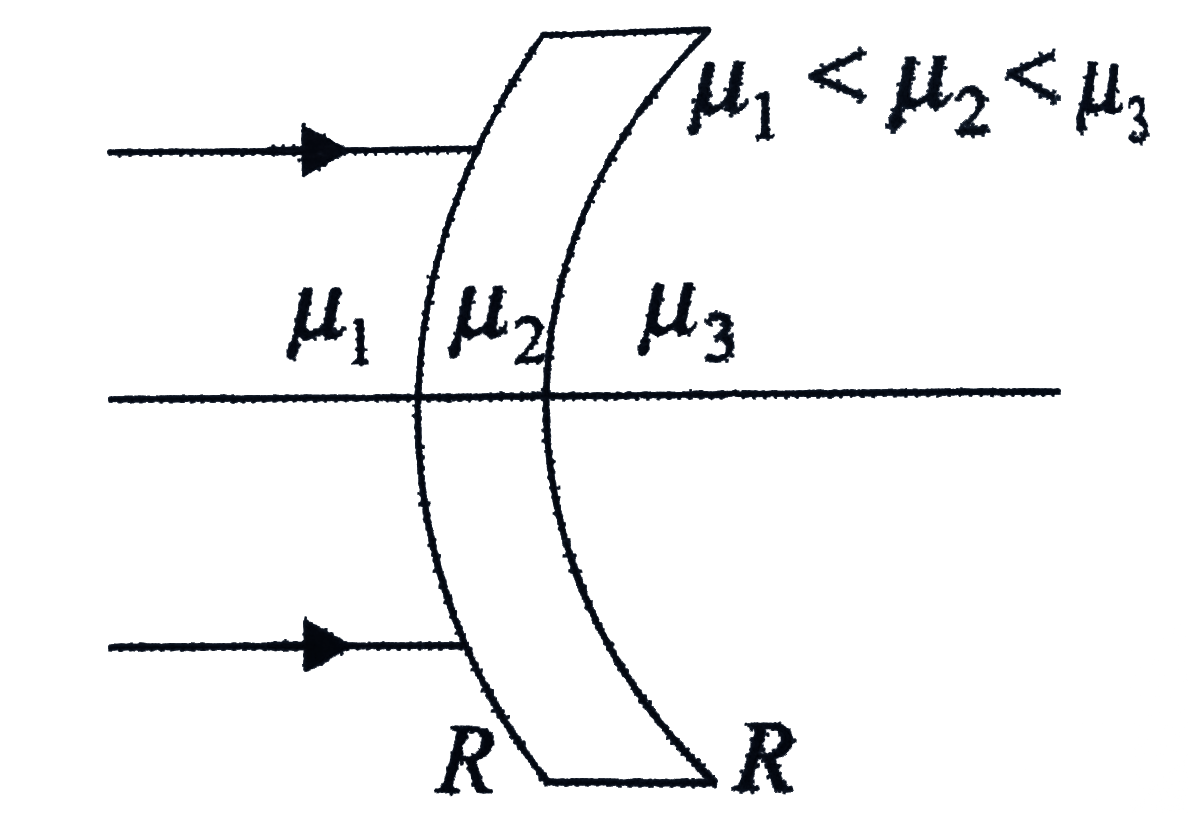 02:42View Solution
02:42View Solution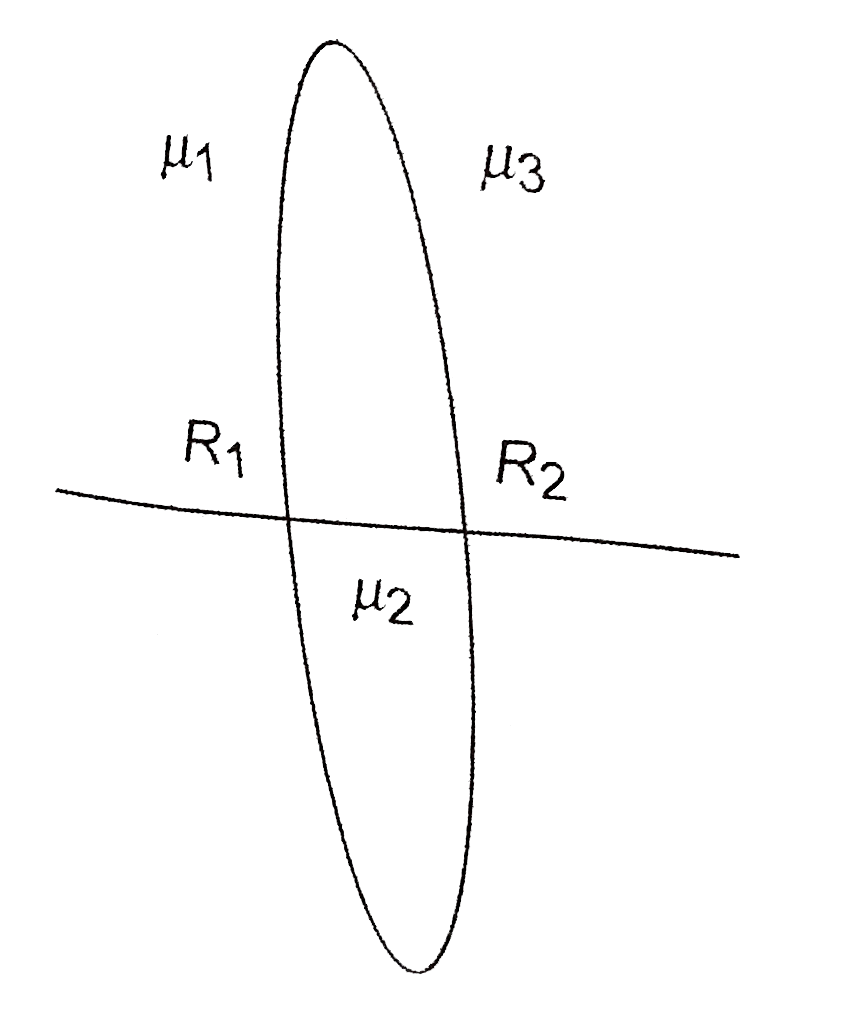
Find the focal length of the lens as shown in figure.View Solution
if `mu_2=._au_g=(3)/(2),mu_3=._au_(omega)=(4)/(3)`, magnitude of radii of carvature of lens are 10 cm and 20 cm find focal length of lens if rays are incident from (a) air and (b) water,View SolutionAn equi-convex lens of `(mu=3//2)` and focal length 10 cm is held with its axis vertical and its lower surface immersed in water `(mu=4//3)`, the upper surface being in air. At what distance from the lens, will a vertical beam of parallel light incident of the lens be focused?
View SolutionA long cylindrical tube containing water in closed by an equinvex lens of local length 10 cm in air. A point source is placed along the axis of the tube outside it at a distance of 21 cm from the lens. Locate the final image of the source. Refractive index of the materials of the lens =1.5 and that of water =1.33.
10:12View SolutionA point object is located at a distance of 15 cm, from the front surface of a thick bi-convex lens. The lens is 10 cm thick and radii of its front and back surfaces are 10 cm and 25 cm respectively. How fae beyond the back surface of this lens `(mu=1.5)` is the image formed?
05:56View SolutionA biconvex thick lens is constructed with glass (mu = 1.50). Each of the surfaces has a radius of 10 cm and the thickness at the middle is 5 cm. Locate the image of an object placed far away from the lens.
06:34View SolutionA plano-convex lens has thickness 4cm. When places on a horizontal table with the curved surface in contact with it, the apparent depth of the bottom-most point of the lens if found to be 3cm. If the lens is inverted such that the plane face is in contact with the table, the apparent depth of the center of the plane face of the lens is face of the lens is found to be `25//8` cm. Find the focal length of the lens.
04:09View Solution(a) A magnifying lens has a focal length of 10 cm, (a) Where should the object be placed if the image is to be 30 cm from the lens ? (b) What will be the magnification ?
(b). A pin length 2.00 cm is placed perpendicular to the principal axis of a converging lens. An inverted image of size 1.00 cm is formed at a distance of 40.0 cm fromthe pin. Find focal length of the lens and its distance from the pin.07:05View SolutionA convex lens produces a double size real image when an object is placed at a distance of 18 cm from it. Where should the object be placed to produce a triple size real image ?
03:57View SolutionA 5.0 diopter lens forms a virtual image which is 4 times the object placed perpendicularly on the principal axis of the lens. Find the distance of the object from the lens.
02:28View SolutionAn object 2.5 cm high is placed in front of a convex lens of focal length 30 cm. If the height of image formed is 5 cm, find the distance between the object and the image?
05:27View SolutionA pin of length 2.0 cm lies along the principal axis of a converging lens, the centre being at a distance of 11 cm from the lens. The focal length of the lens is 6 cm. Find the size of the image.
03:33View SolutionThe distance between two point sources of light is `24cm.` Find out where would you place a converging lens of focal length `9cm,` so that the images of both the sources are formed at the same point.
03:55View SolutionA point object is placed on the principal axis of a convex lens (f = 15 cm) at a distance of 30 cm from it. A glass plate `(mu= 1.50)` of thickness 1 cm is placed on the other side of the lens perpendicular to the axis. Locate the image of the point object.
03:12View SolutionA convex lens is held `45 cm` above the bottom of an empty tank. The image of a point at the bottom of a tank is formed `36 cm` above the lens. Now, a liquid is poured into the tank to a depth of `40 cm.` It is found that the distance of the image of the same point on the bottom of the tank is `48 cm` above the lens. Find the refractive index of the liquid.
04:18View SolutionA small fish 0.4 m below the surface of a lake is viewed through a simple converging lens of focal length 3 m.the lens is kep at 0.2 m above the water surface such that the fish lies on the optical axis of the lens. Find the image of the fish seen by the observed. `(mu_(water)=(4)/(3))`
04:10View SolutionA converging beam of light forms a sharp image on a screen. A lens is placed in the path of the beam at `10 cm` from the screen. It is found that the screen has to be moved `8 cm` further away from the lens to obtain a sharp image. Find the focal length and nature of the lens.
02:27View SolutionA point object O is placed at a distance of 0.3 m from a convex lens of focal length 0.2 m. It is then cut into two halves each of which is displaced by 0.0005 m as shown in figure.

image will be formed from the lens at a distance of03:34View SolutionAn image Y is formed of a point object x by a lens whose optic axis is AB as shown in Figure. Draw a ray diagram to locate the lens and its focus. If the image Y of object X is formed by a concave mirror (having the same optic axis AB) instead of lens, draw another ray diagram to locate the mirror and its focus. Write down the steps of construction of the ray diagrams.
 01:48View Solution
01:48View SolutionA point object moves along the principal axis of a convex lens of focal length `f`, such that its image also formed on the principal axis at a distance `(4f)/(3)` (at `t=0`) moves away from the lens with a uniform velocity `alpha`. Find the velocity of point source as a function of time `t`.
07:58View SolutionAn object is placed at a distance of 75 cm from a screen. Where should a convex lens of focal length 12 cm be placed so as to obtain a real image of the object?
04:03View SolutionA thin plano-convex lens of focal length f is split into two halves. One of the halves is shifted along the optical axis as shown in figure. The separation between object and image planes is 1.8 m. The magnification of the image, formed by one of the ball lens is 2. Find the focal length of the lens and separation between the two halves. Draw the ray diagram for image formation.
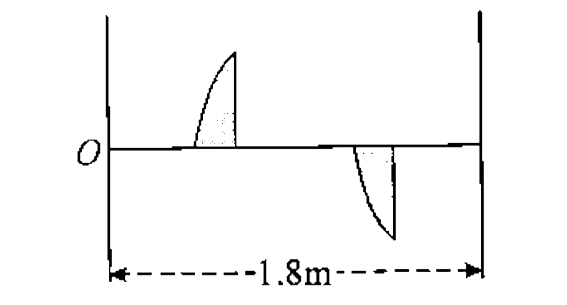 04:09View Solution
04:09View SolutionTwo plano-concave lenses of glass of refractive index 1.5 have radii of curvature of 20 and 30 cm. They are placed in contact with curved surface towards each other and the space between them is filled with a liquid of refractive index `(4)/(3)`, find the focal length of the system.
05:55View SolutionA point object is placed at a distance of 15 cm from a convex lens. The image is formed on the other side at a distance of 30 cm from the lens. When a concave lens is placed in contact with the convex lens, the image shifts away further by 30 cm. Calculate the focal lengths of the two lenses.
04:29View SolutionA 5 mm high pin is placed at a distance of 15 cm from a convex lens of focal length 10 cm. A second lens of focal length 5 cm is placed 40 cm from the first lens and 55 cm from the pin. Find (a) the position of the final image, (b) its nature and (c) its size.
05:15View SolutionA concave convex figure lens made of glas `(mu=1.5)` has surface of radii 20 cm and 60 cm. a. Locate the image ofan object placed 80 cm to the left of the lens along the principal axis. B. A similar lens is placed coaxially at distanc of 160 cm right of it. Locate the position of the image.
 05:17View Solution
05:17View SolutionA convex lens A of focal length `20 cm` and a concave lens B of focal length `5 cm` are kept along the same axis with a distance d between them. If a parallel beam of light falling on A and B as a parallel beam, then d is equal to ……cm
04:25View SolutionA convex lens of focal length 20 cm and a concave lens of focal length 10 cm are placed 10 cm apart with their principal axes coinciding. A beam of light travelling parallel to the principal axis and having a beam diameter 5.0 mm, is incident on the combination. Show that the emergent beam is parallel to the incident one. Find the beam diameter of the emergent beam.
04:55View SolutionA diverging lens of focal length 20 cm and a converging lens of focal length 30 cm are placed 15 cm apart with their principal axes coinciding. Where should an object be placed on the principal axis so that its image formed at infinity ?
03:29View SolutionTwo convex lenses each of focal length 10 cm, are placed at a saparation of 15 cm with their principal axes coinciding. (a) Show that a light beam coming parallel to the principal axis diverges as it comes out of the lens system. (b) Find the location of the virtual image formed by the lens system of an object placed far away. (c ) Find the focal lenth of the equivalent lens.
06:30View SolutionA converging lens of focal length 15 cm and a converging mirror of focal length 10 cm are placed 50 cm apart. If a pin of length 2.0 cm is placed 30 cm from the lens farther away from the mirror, where will the final image form and what will be the size of the final image ?
05:15View SolutionA converging lens of focal length 15 cm and a converging mirror of focal length 10 cm are placed 50 cm apart with common principal axis. A point source is placed in between the lens and the mirror at a distance of 40 cm from the lens. Find the locations of the two images formed.
06:18View SolutionA concave lens of focal length 20 cm is placed 15 cm in front of a concave mirror of radius of curvature 26 cm and further 10 cm away from the lens is placed an object. The principal axis of the lens and the mirror are coincident and the object is on the axis Find the position and nature of the image.
07:49View SolutionA conveying lens of focal length 15 cm and a converging mirror of focal length 20 cm are placed with their principal axes coinciding. A point source S is placed on the principal axis at a distance of 12 cm from the lens as shown in figure. It is found that the final beam comes out parallel to the principal axis. Find the separation between the mirror and the lens.
07:02View Solution(a) A point source S is placed at a distance of 15 cm from a converging lens of focal length 10 cm on its principal axis, where should a diverging mirror of focal length 12 cm be placed so that a real image is formed on the source itself?
(b) A diverging lens of focal length 20 cm and a converging mirror of focal length 10 cm are placed coaxially at separation of 5 cm. Where should an object be placed so that a real image is formed at the object itself?
(c) A converging lens of focal length 12 cm and a diverging mirror of focal length 7.5 cm are placed 5.0 cm apart with the principal axis coinciding where should an object be placed so that its image falls on itself?10:31View SolutionA converging lens and a diverging mirror are placed at a separation of 15 cm. The focal length of the lens is 25 cm and that of the mirror is 40 cm. Where should a point source be placed between the lens and the mirror so that the light, after getting reflected by the mirror and then getting transmitted by the lens, comes out parallel to the principal axis ?
04:46View SolutionA concave mirror of radius R is kept on a horizontal table. Water (refractive index =mu.) is poured into it up to a height h. Where should an object be placed so that its image is formed on itself ?
 02:40View Solution
02:40View SolutionA concave mirror of radius 40 cm lies on a horizontla tale and wateis filled in it up t a heightof 5.00 cm. A small dust particle floats on the water surface at a point P vertically above tge pointof contact of the miror with the table. Locate the image of the dust particle as seen from a point directly above it. tEh refractie index of water is 1.33.
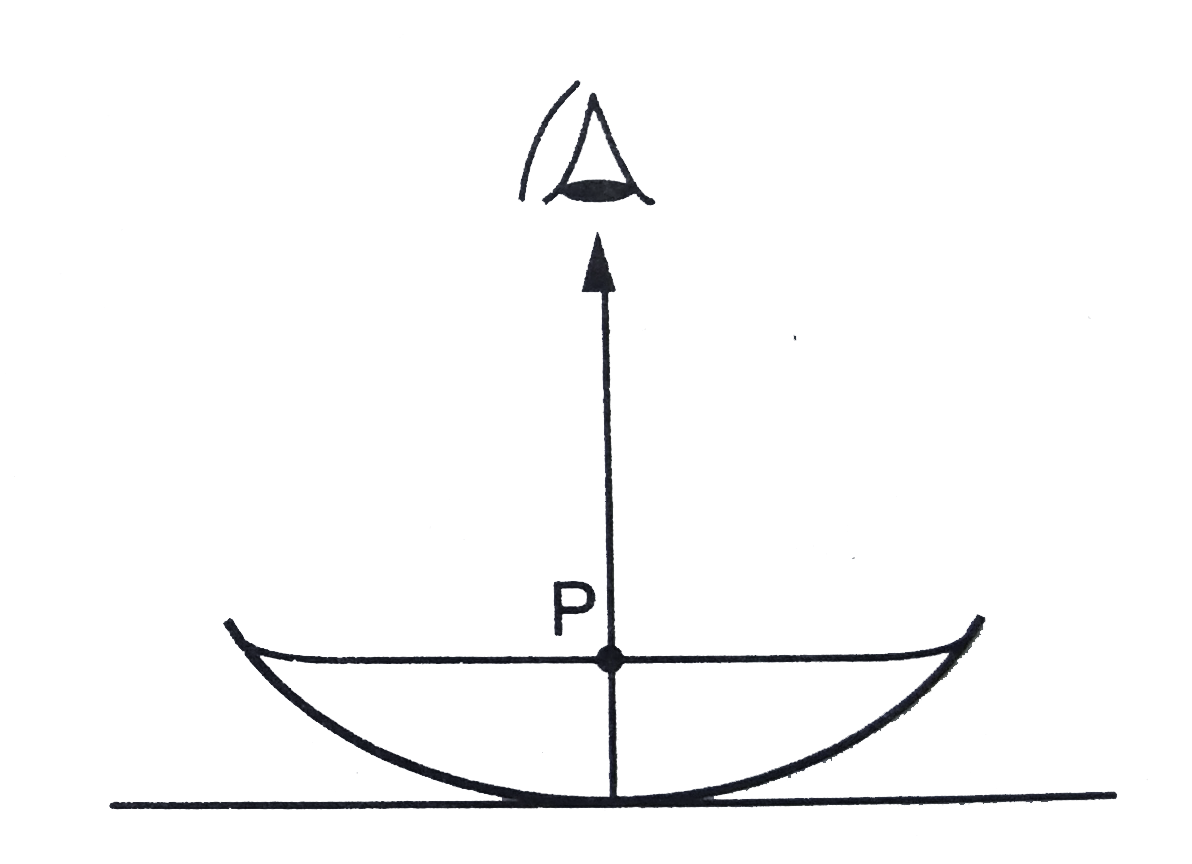 05:10View Solution
05:10View SolutionThe radius of curvature of the convex face of a plano-convex lens is `12` cm and its refractive index is `1.5` (a)Find the focal length of this lens.The plane surface of the lens is now silvered.(b)At what distance from the lens will parallel rays incident on the convex face converge?(c)Sketch the ray diagram to locate the image,when a point object is placed on the axis `20 cm`from the lens (d)Calculate the image distance when the object is placed as in (c).
09:49View SolutionThe convex lens of a thin plano-convex lens `(mu=1.5)` with `R=60cm` is silvered to obtain a concave mirror. An object is located at a distance 25 cm in front of this mirror, find the distance of the image from mirror.
06:09View SolutionA pin is placed 10cm in front of a convex lens of focal length 20cm, made of a material having refractive index 1.5 . The surface of lens farther away from the pin is silvered and has a radius of curvature 22cm. Determine the position of the final image. Is the image real or virtual?
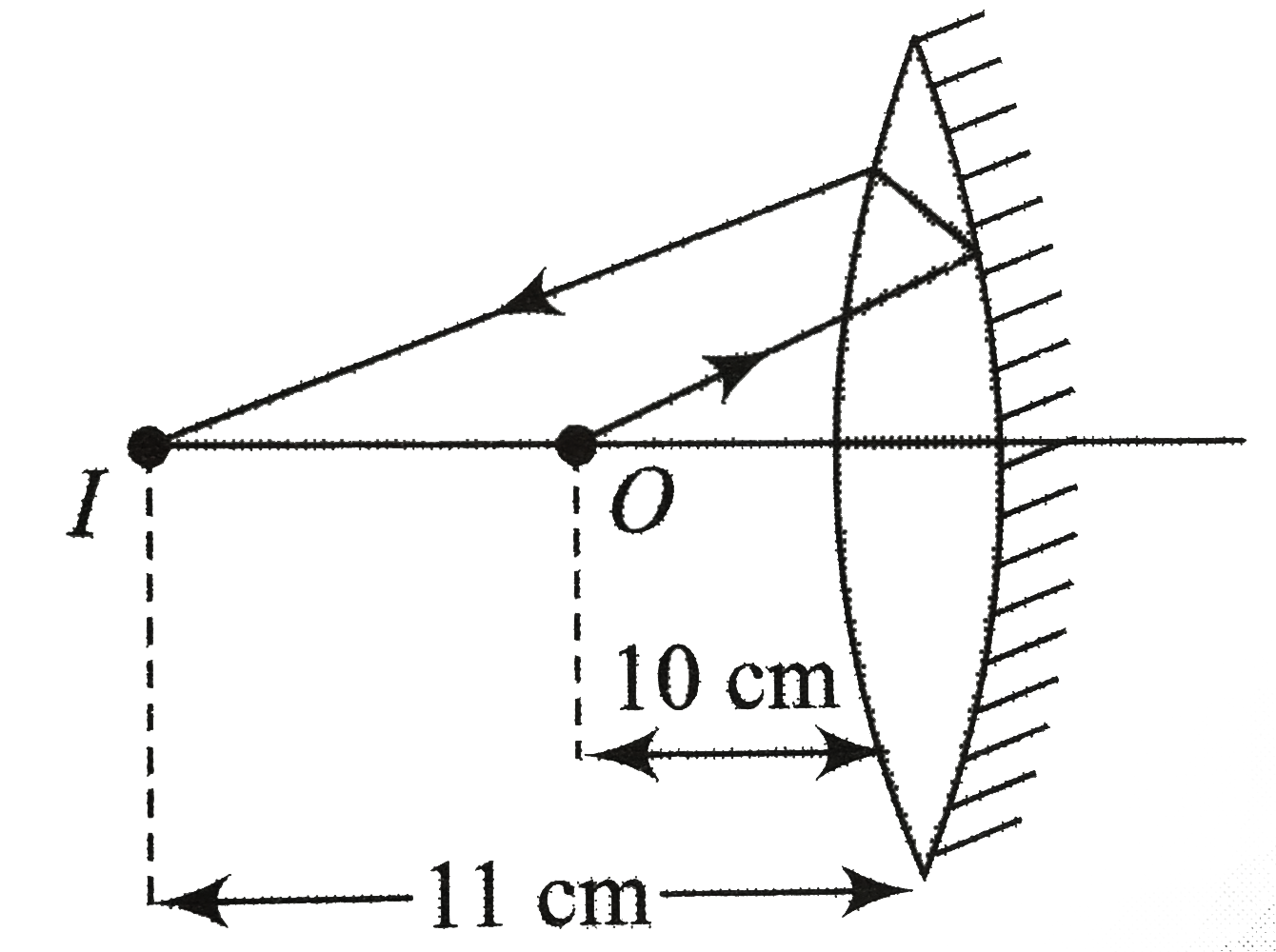 07:50View Solution
07:50View SolutionA biconvex thin lens is prepared from glass `(mu=1.5)`, the two bounding surfaces having equal radii of 25 cm each. One of the surfaces is silvered from outside to make it reflecting. Whee should an object be placed before this lens so that the image is formed on the object itself?
 03:26View Solution
03:26View SolutionThe convex surface of a thin concave-convex lens of glass of refractive index 1.5 has a radius of curvature 20 cm. The concave surface has a radius of curvature 60 cm. The convex side is silvered and placed on a horizontal surface as shown in figure. (a) Where should a pin be placed on the axis so that its image is formed at the same place ? (b) If the concave part is filled with water (mu = 4/3), find the distance through which the pin should be moved so that the image of the pin again coincides with the pin.
 08:54View Solution
08:54View SolutionA thin gollow equiconvex lens, silvered at the back, converges a parallel beam of light at a distance of 0.2 m in front of it. Where will it converge the same light if filled with water having `mu=(4//3)`?
04:42View SolutionOne side of radius of curvature `R_2=120 cm` of a convexo-convex lens of material of refractive index `mu=1.5` and focal length `f_1=40 cm` is slivered. It is placed on a horizontal surface with silvered surface in contact with it. Another convex lens of focal length `f_2=20 cm` is fixed coaxially `d=10 cm` above the first lens. A luminous point object O on the axis gives rise to an image coincide with it. Find its height above the upper lens.
07:12View SolutionA thin equiconvex lens of refractive index `3//2` is placed on a horizontal plane mirror as shown in figure. The space between the lens and the mirror is filled with a liquid of refractive index `4//3` . It is found that when a point object is placed 15 cm above the lens on its priincipal axis, the object coincides with its own image.

Q. If another liquid is filled instead of water, the object and the image coincide at a distance 25 cm from the lens.
Calculate the refractive index of the liquid.06:04View SolutionThe radius of curvature of the curved surfaces of an equiconvex lens is 32 cm and its refractive index is `mu = 1.5`. One of its side is silvered and placed 14 c away from an object as shown in figure. At what distance x should a second convex lens of focal length 24 cm be placed so that the image coincides with the object.
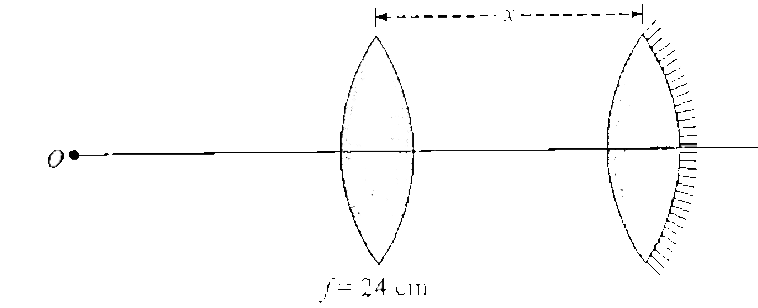 05:26View Solution
05:26View Solution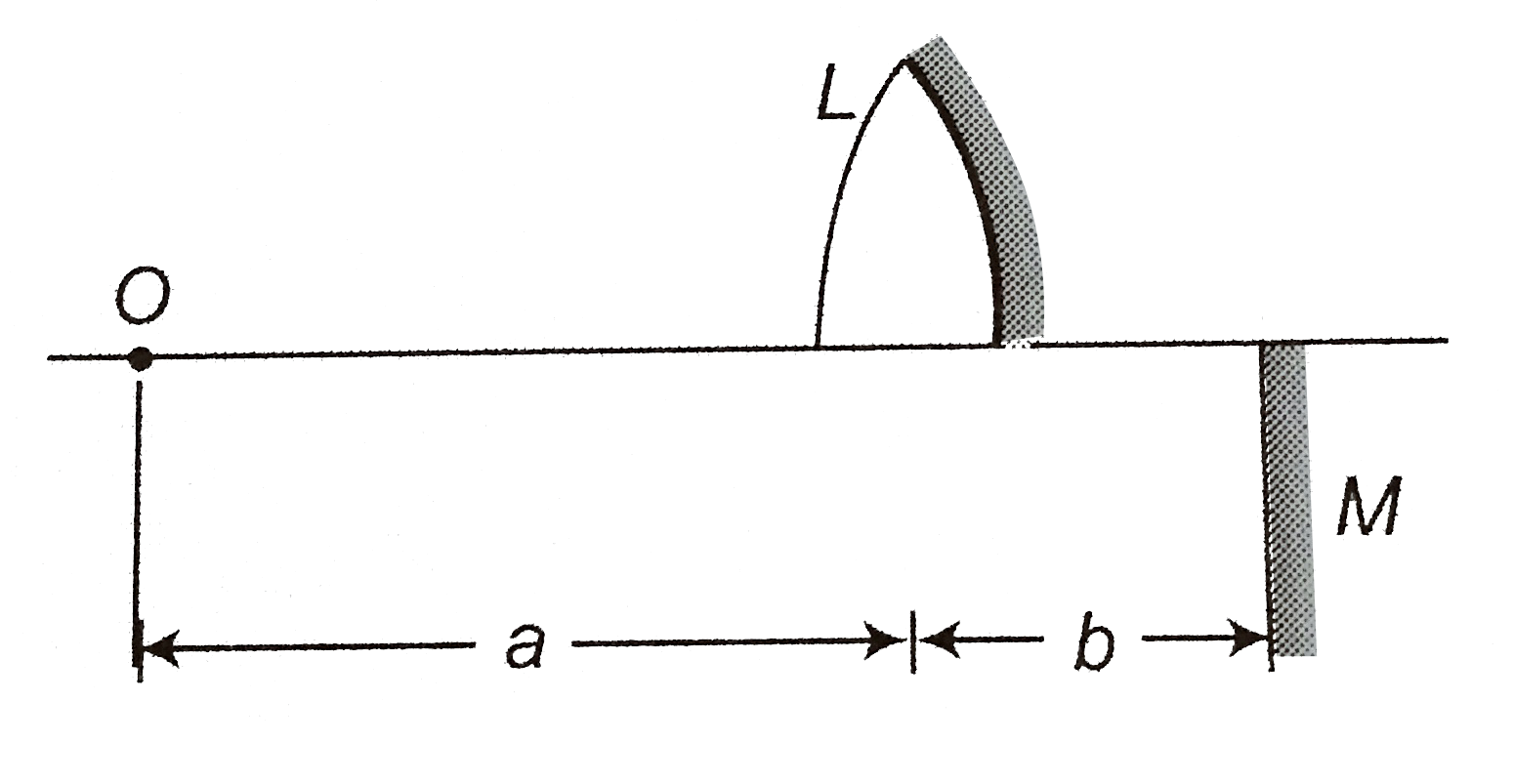
As shown in figure. L is half part of an equiconvex lens `(mu=1.5)` whose surface have radius of curvature `R=40cm` and its right surface in silvered. Normal to principal axis, a plane mirror M is placed on the right of lens. A small object O is placed on left of the lens such that there is no parallax between final images formed by the lens and mirror. If transverse length of final image formed by the lens is twice that of image formed by the mirror. Calculate distance a between lens and object and distance `b`.View Solution
Example questions and complete solutions for chapter REFRACTION AT SPHERICAL SURFACES of CP SINGH PHYSICS (HINGLISH) of Class 12
